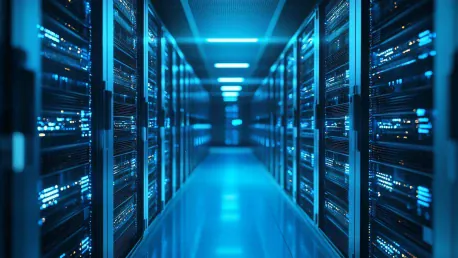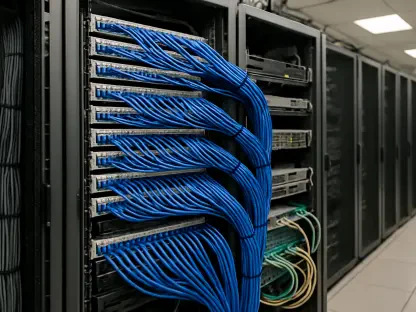The rapid proliferation of artificial intelligence (AI) technology is fundamentally altering the landscape of data centers worldwide. This transformation is reflected in the significant increase in global data center capital expenditure (CapEx), projected to grow from $430 billion in 2024 to $1.1 trillion by 2029. This surge underscores the critical role AI plays in driving demand for enhanced data center infrastructure, including servers, power, and cooling systems.
The AI Revolution in Data Centers
Increased Investment in AI-Optimized Servers
The rising demand for AI technology is compelling enterprises to allocate a larger portion of their budgets to AI-optimized servers. In 2023, these servers accounted for 15% of data center CapEx budgets, a figure that rose to 35% by 2024 and is expected to reach 41% by 2029. Hyperscale cloud service providers such as Amazon, Google, Meta, and Microsoft are leading this AI-driven transformation, investing heavily in high-performance servers that are specifically designed to handle AI workloads efficiently.
This investment trend reflects a broader shift towards infrastructure that supports AI and Machine Learning (ML) applications. Such high-performance servers are equipped with specialized processors, including GPUs and TPUs, which can efficiently manage complex computations and large datasets typical of AI applications. As AI continues to advance, the hardware requirements become more specialized and resource-intensive, necessitating higher and more focused investments to keep pace with technological developments.
Financial Implications of AI Servers
AI-optimized servers are considerably more expensive than traditional servers, often costing between $100,000 to $200,000, especially when equipped with the latest Nvidia CPUs. This contrasts sharply with the $7,000 to $8,000 cost of traditional servers, highlighting the significant financial investment required to support AI workloads. The increased cost, however, comes with substantial performance benefits, enabling faster processing speeds, improved computational efficiency, and the ability to manage larger volumes of data simultaneously.
This financial outlay represents a strategic long-term investment for many enterprises, as the returns on AI implementation can be substantial. AI-driven insights can lead to innovations in product development, optimization of operational workflows, and improved decision-making processes. As organizations continue to recognize the potential of AI, the willingness to invest in costly, high-performance servers reflects a calculated risk with the expectation of significant returns and competitive advantage.
Public Cloud vs. On-Premises AI Workloads
Initial AI Workloads in Public Cloud
Due to the high cost and potentially low utilization of AI infrastructure in private data centers, AI workloads are initially expected to be handled predominantly in public cloud environments. This trend is likely to continue until enterprises gain a better understanding of their AI workload utilization. Public cloud providers possess the scale and resources to deploy AI infrastructure on a large scale, offering users the flexibility to scale their operations based on demand without the hefty upfront investment.
Public cloud services provide significant advantages, such as access to cutting-edge infrastructure, the ability to pay for usage on demand, and the reduction of risks associated with over-provisioning or underutilization. Public cloud platforms also offer comprehensive AI toolsets and frameworks that facilitate the deployment, monitoring, and scaling of AI models. These factors make it an ideal starting point for organizations venturing into AI, providing a testing ground to understand specific workload demands before committing to dedicated infrastructure.
Potential Shift to On-Premises Data Centers
As enterprises become more adept at managing AI workloads, there is potential for some AI tasks to transition back to on-premises data centers. This shift could be driven by factors such as cost-efficiency and improved utilization of AI infrastructure. On-premises deployments can offer enhanced control over data security, compliance, and performance optimization tailored specifically to the needs of the organization.
The move back to on-premises setups aligns with the maturity and standardization of AI applications within an enterprise. Once the specific AI needs and workload patterns are better understood, organizations may find it cost-effective to invest in private AI infrastructure. This shift also responds to growing concerns about data privacy and the need to comply with regulatory requirements, which can be managed more effectively within a private data center environment.
Advancements in AI and Data Center Efficiency
Cost-Efficient AI Models
Innovations in AI, such as the open-source AI model from DeepSeek, demonstrate that large language models (LLMs) can achieve high-quality results at low costs through strategic architectural changes. These advancements are likely to inspire other AI companies to pursue similar cost-efficiency measures. By optimizing the architecture, organizations can reduce the computational resources required, thereby lowering costs while maintaining high performance.
These strategies not only make AI more accessible to a broader range of companies but also drive competition and innovation within the AI market. By focusing on cost-efficiency without compromising on performance, AI development is poised to become more economically sustainable, enabling smaller players to participate and contribute to the AI economy. This inclusivity has the potential to democratize access to AI technology, fostering a broader scope of innovation and application.
Custom AI Chips and Accelerators
Hyperscalers are developing custom chips tailored to their specific AI workloads, contributing to the growth of the accelerator market. This market, which includes custom accelerators and GPUs, is projected to reach $392 billion by 2029, with custom accelerators expected to outpace commercially available options. Custom chips provide a notable advantage in optimizing performance for specific AI tasks, driving efficiency, and reducing latency.
The evolution of custom AI chips illustrates the ongoing need for specialized hardware as AI applications become increasingly sophisticated. Companies that develop these chips can better align their hardware capabilities with their unique AI workloads, ensuring maximum efficacy and reducing operational costs. This shift underscores a broader trend towards vertical integration in the tech space, where companies seek to optimize every aspect of their hardware and software ecosystem for peak performance.
Impact on Networking, Power, and Cooling
Networking Requirements
The deployment of dedicated AI servers necessitates significant advancements in networking. The Ethernet network adapter market, crucial for supporting back-end networks in AI compute clusters, is expected to grow at a compound annual growth rate of 40% by 2029. High-performance networking is essential to managing the vast data flows and ensuring seamless communication between AI servers, which operate in heavily interconnected environments.
These accelerated growth rates reflect the increased data throughput and low latency required by AI-driven processes. As AI models become larger and more complex, the demand for network speeds and bandwidth will consequently rise, necessitating investment in next-generation networking technologies. The development of advanced networking solutions is crucial to ensuring that the broader infrastructure can sustain the performance levels required for AI operations.
Power and Cooling Demands
AI-powered infrastructure is highly power-intensive, with current average rack power densities around 15 kilowatts per rack. AI workloads demand significantly more, requiring between 60 and 120 kilowatts per rack. This increase in power density necessitates more robust cooling solutions, prompting data center operators to adopt liquid cooling methodologies. Traditional air cooling systems are proving inadequate for these high-power densities, pushing the industry to explore more efficient cooling techniques.
This escalating demand for power is a direct consequence of the increased complexity and size of AI models, which require vast amounts of computational resources. Efficient cooling solutions are vital to preventing overheating, maintaining hardware longevity, and ensuring optimal performance. Liquid cooling becomes a necessity rather than an option, as it offers superior heat dissipation capabilities and can handle the elevated power loads typical of advanced AI applications.
Transition to Liquid Cooling
Limitations of Air-Cooling Systems
Traditional air-cooling systems, effective up to about 50 kilowatts per rack, are being challenged by the higher power densities required by AI applications. As a result, liquid cooling is becoming increasingly prevalent in data centers. Liquid cooling systems can manage the heat generated by high-performance AI servers more effectively, ensuring stable operation and preventing thermal throttling that can compromise computational efficiency.
This shift towards liquid cooling reflects a broader trend in data center design, where efficiency and sustainability are becoming paramount. As AI continues to drive up power densities, data centers must adapt by adopting more advanced cooling solutions that not only meet current demands but also offer scalability for future growth. These advancements help mitigate the environmental impact associated with the rising energy consumption of data centers, aligning with broader goals of sustainability and energy efficiency.
Adoption of Liquid Cooling Technologies
The swift advancement of AI technology is fundamentally reshaping the framework of data centers around the world. This transformation is evident in the substantial rise in global data center capital expenditure (CapEx), which is anticipated to increase from $430 billion in 2024 to an impressive $1.1 trillion by 2029. This dramatic growth highlights the critical importance of AI in escalating the demand for advanced data center infrastructure. Key components such as servers, power systems, and cooling mechanisms are now required to be more robust and capable, addressing the intensive needs posed by AI operations. The burgeoning data requirements necessitate these investments, ensuring data centers can efficiently support AI’s complex and resource-heavy processes. This trend indicates a future where AI’s influence on data center architecture and funding will only grow more pronounced, reflecting its integral role in technological advancements.









